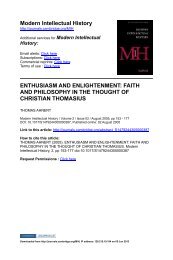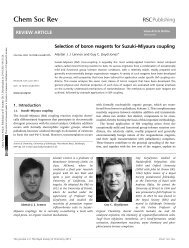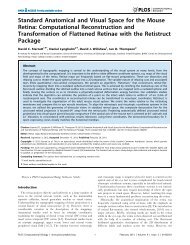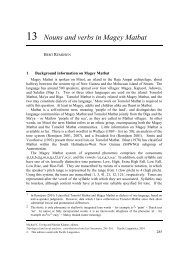Sturgeon fishing in the middle and lower Danube region László ...
Sturgeon fishing in the middle and lower Danube region László ...
Sturgeon fishing in the middle and lower Danube region László ...
Create successful ePaper yourself
Turn your PDF publications into a flip-book with our unique Google optimized e-Paper software.
from <strong>the</strong> prehistoric site of Schela Cladovei.<br />
O<strong>the</strong>r equipment<br />
By <strong>the</strong> 19th–20th century hardly any references to sturgeon<br />
weirs occur <strong>in</strong> Hungary (Szilágyi 1995: 108). Large <strong>and</strong><br />
strong, so-called pipola nets, were made especially for sturgeon<br />
<strong>fish<strong>in</strong>g</strong> out of hemp. However, by <strong>the</strong> second half of <strong>the</strong><br />
19th century large sturgeons became scarce (cf. Fig. 3), so<br />
that <strong>the</strong>se special nets were used but rarely (Herman 1887:<br />
281). <strong>Sturgeon</strong>s could also be caught with gill nets, suspended<br />
vertically <strong>in</strong> <strong>the</strong> water to trap fish by <strong>the</strong>ir gills, as <strong>the</strong><br />
strong pectoral f<strong>in</strong>s of sturgeons easily became hooked <strong>in</strong> its<br />
meshes (von Br<strong>and</strong>t 1964: 170).<br />
<strong>Sturgeon</strong>s were also caught us<strong>in</strong>g sharp hooks strung on a<br />
strong rope <strong>and</strong> stretched across rivers. In contrast to similar<br />
methods of catfish (Silurus glanis L<strong>in</strong>né 1758) <strong>fish<strong>in</strong>g</strong>, such<br />
hooks did not have to be baited, s<strong>in</strong>ce curious sturgeons often<br />
‘played’ with <strong>the</strong>se glossy pieces of metal <strong>and</strong> were caught by<br />
chance (Kh<strong>in</strong> 1957: 16). By <strong>the</strong> late 19th century, such hooks<br />
became <strong>the</strong> primary means of sturgeon <strong>fish<strong>in</strong>g</strong> (Herman<br />
1887: 368).<br />
Lake sturgeons <strong>in</strong> North America could be speared even<br />
from <strong>the</strong> shore <strong>in</strong> shallow waters (Needs-Howarth 1996:<br />
149). Fish, <strong>in</strong>jured <strong>and</strong> dazed, were <strong>the</strong>n dragged near <strong>the</strong><br />
bank. Accord<strong>in</strong>g to Marsigli (1726), fishermen enveloped<br />
such fish <strong>in</strong> a large net <strong>in</strong> <strong>the</strong> <strong>Danube</strong> <strong>and</strong> provoked it fur<strong>the</strong>r<br />
onto <strong>the</strong> bank by ‘titillat<strong>in</strong>g’ it until it became str<strong>and</strong>ed.<br />
Captured sturgeons were sometimes kept te<strong>the</strong>red to trees or<br />
strong poles, before be<strong>in</strong>g towed upstream by boat to <strong>the</strong><br />
nearest market. The capitals of Buda <strong>and</strong> Vienna were supplied<br />
with live sturgeon <strong>in</strong> this way (Bél 1764: 41).<br />
Aside from hefty hooks <strong>and</strong> harpoons, grapnels must have<br />
been important tools <strong>in</strong> l<strong>and</strong><strong>in</strong>g <strong>the</strong>se large fish at all times.<br />
By <strong>the</strong> 18th century, <strong>the</strong> great sturgeons were even ‘hunted’<br />
with firearms (Marsigli 1726, <strong>in</strong> Deák 2004: 74).<br />
Cognitive aspects of sturgeon <strong>fish<strong>in</strong>g</strong><br />
<strong>László</strong> Bartosiewicz et al.: <strong>Sturgeon</strong> <strong>fish<strong>in</strong>g</strong> <strong>in</strong> <strong>the</strong> <strong>middle</strong> <strong>and</strong> <strong>lower</strong> <strong>Danube</strong> <strong>region</strong><br />
<strong>Sturgeon</strong>s were <strong>the</strong> largest fish <strong>in</strong> <strong>the</strong> <strong>Danube</strong>. Their sheer<br />
size <strong>and</strong> powerful movement must have impressed people<br />
throughout history. The renowned abundance of sturgeons<br />
dur<strong>in</strong>g <strong>the</strong> spawn<strong>in</strong>g run must have fur<strong>the</strong>r enhanced <strong>the</strong>ir<br />
awesome perception. Thus, it is likely that <strong>the</strong>se great beasts<br />
had dualistic symbolic mean<strong>in</strong>gs related to both life <strong>and</strong><br />
death <strong>in</strong> <strong>the</strong> spiritual life of peoples <strong>in</strong> <strong>the</strong> <strong>region</strong>.<br />
Positive perceptions<br />
Isotopic studies of human rema<strong>in</strong>s by Bonsall et al. (1997,<br />
2000, 2004) have confirmed <strong>the</strong> results of previous faunal<br />
analyses (e.g. Bökönyi 1978, Bartosiewicz et al. 1995), <strong>in</strong>dicat<strong>in</strong>g<br />
that Mesolithic populations <strong>in</strong> <strong>the</strong> Iron Gates consumed<br />
considerable amounts of fish (aquatic resources were<br />
still exploited dur<strong>in</strong>g <strong>the</strong> Early Neolithic, but <strong>the</strong> dietary role<br />
of terrestrial resources <strong>in</strong>creased). Even if sturgeon was<br />
available on a seasonal basis, ow<strong>in</strong>g to <strong>the</strong> quantities of meat<br />
even s<strong>in</strong>gle <strong>in</strong>dividuals yielded, its contribution to <strong>the</strong> diet<br />
cannot be underestimated, <strong>and</strong> probably determ<strong>in</strong>ed <strong>the</strong> prehistoric<br />
perception of <strong>the</strong>se animals.<br />
Highly valued sturgeon meat won <strong>the</strong> name ‘Royal Fish’<br />
51<br />
for beluga sturgeon <strong>in</strong> Medieval Hungary. Aside from <strong>the</strong><br />
impressive quantity of food provided by a s<strong>in</strong>gle specimen,<br />
<strong>the</strong> quality of sturgeon flesh was also appreciated, regardless<br />
of size. Of <strong>the</strong> species that resembled great sturgeon, Marsigli<br />
(1726) devoted most attention to <strong>the</strong> small sterlet whose meat<br />
was said to be simply ‘<strong>the</strong> best’. A quarter of a millennium<br />
later, this view was confirmed dur<strong>in</strong>g ethnographic <strong>in</strong>terviews<br />
conducted by Vasile Şişu among <strong>the</strong> fishermen of<br />
Dubova district (Iron Gates gorge, Romania).<br />
Accord<strong>in</strong>g to <strong>the</strong> Torah, only fish with scales <strong>and</strong> f<strong>in</strong>s are<br />
kosher. Accord<strong>in</strong>gly, <strong>the</strong> bones of sturgeon <strong>and</strong> similarly<br />
scaleless catfish occurred only <strong>in</strong> <strong>the</strong> Christian layers above<br />
deposits associated with <strong>the</strong> 13th century Jewish community<br />
<strong>in</strong> a well excavated <strong>in</strong> <strong>the</strong> Buda Royal Castle <strong>in</strong> Hungary. The<br />
latter conta<strong>in</strong>ed only rema<strong>in</strong>s of kosher carp-like fish<br />
(Cypr<strong>in</strong>idae) <strong>and</strong> high status pike (Esox lucius L.;<br />
Bartosiewicz 2003). The ganoid type (Lagler et al. 1977: 108,<br />
fig. 4.2) scutes of sturgeon are not considered scales <strong>in</strong> this<br />
religious context, s<strong>in</strong>ce <strong>the</strong> sk<strong>in</strong> is often torn dur<strong>in</strong>g descal<strong>in</strong>g<br />
that renders <strong>the</strong> fish tref. <strong>Sturgeon</strong> meat <strong>and</strong> caviar<br />
<strong>the</strong>refore were avoided by Ashkenazi Jews who settled <strong>in</strong><br />
Medieval Eastern Europe. ‘Legaliz<strong>in</strong>g’ sturgeon meat with<br />
reference to its ganoid scales, however, became an important<br />
halachic issue <strong>in</strong> <strong>the</strong> early 19th century Jewish religious reform<br />
<strong>in</strong> Hungary (Frojimovics et al. 1995: 293).<br />
Needs-Howarth (1996: 153) concluded that concentrations<br />
of lake sturgeon bones at certa<strong>in</strong> archaeological sites <strong>in</strong><br />
Canada <strong>in</strong>dicate that <strong>the</strong>se animals had mythical or religious<br />
mean<strong>in</strong>g for Iroquoian people. In <strong>the</strong>ir artistic renditions of<br />
Lake Superior native American mythology, Longfellow<br />
(1855) <strong>and</strong> Kohl (1859 II: 143) <strong>in</strong>deed equate <strong>the</strong> ‘K<strong>in</strong>g of<br />
Fishes’ with sturgeon.<br />
It is not difficult to imag<strong>in</strong>e that <strong>the</strong> much-awaited spr<strong>in</strong>g<br />
arrival of masses of sturgeon amounted to some sort of a feast<br />
dur<strong>in</strong>g <strong>the</strong> Mesolithic <strong>and</strong> Early Neolithic of <strong>the</strong> Iron Gates.<br />
Accord<strong>in</strong>g to a structuralist <strong>in</strong>terpretation by Radovanović<br />
(1997: 88–89), <strong>the</strong> upstream movement of beluga sturgeon<br />
may have symbolized life to <strong>the</strong> prehistoric <strong>in</strong>habitants of <strong>the</strong><br />
gorge, possibly counterweighted by <strong>the</strong> downstream orientation<br />
of <strong>the</strong> deceased <strong>in</strong> Mesolithic burials along <strong>the</strong><br />
riverbank. 1<br />
Negative perceptions<br />
The perception of animals tends to be dualistic, rang<strong>in</strong>g<br />
between extremes (Bartosiewicz 1998: 69). At <strong>the</strong> prehistoric<br />
site of Lepenski Vir <strong>in</strong> <strong>the</strong> Iron Gates gorge, <strong>the</strong> stone statue<br />
dubbed Danubius by <strong>the</strong> excavator (Srejović 1972: fig. 52)<br />
has been tentatively identified with sturgeon, hav<strong>in</strong>g even a<br />
crest of ‘dermal scutes’ carved along its back (Radovanović<br />
(1997: 93, figs. 1–2). Although <strong>the</strong> exaggerated, even frighten<strong>in</strong>g,<br />
facial features (such as <strong>the</strong> large, bulg<strong>in</strong>g eyes) are not<br />
at all rem<strong>in</strong>iscent of <strong>the</strong> modern perception of sturgeons —<br />
sturgeon have very small eyes (cf. Fig. 4), this hypo<strong>the</strong>sis is<br />
not implausible if, as suggested by Srejović (1972: 111), <strong>the</strong><br />
sculpture was conceived as an apotropaic representation with<br />
<strong>the</strong> power to avert evil or catastrophe. Bonsall et al. (2002)<br />
suggested that <strong>the</strong> Lepenski Vir sculptures were <strong>in</strong>tended to<br />
protect aga<strong>in</strong>st unpredictable <strong>and</strong> catastrophic floods. If so,<br />
<strong>the</strong> ability of sturgeon to swim aga<strong>in</strong>st <strong>the</strong> flow even at times<br />
of high discharge, overcom<strong>in</strong>g <strong>the</strong> power of <strong>the</strong> river, may









